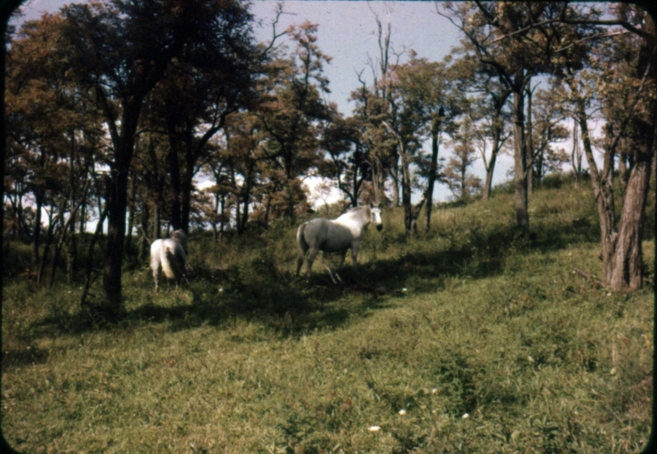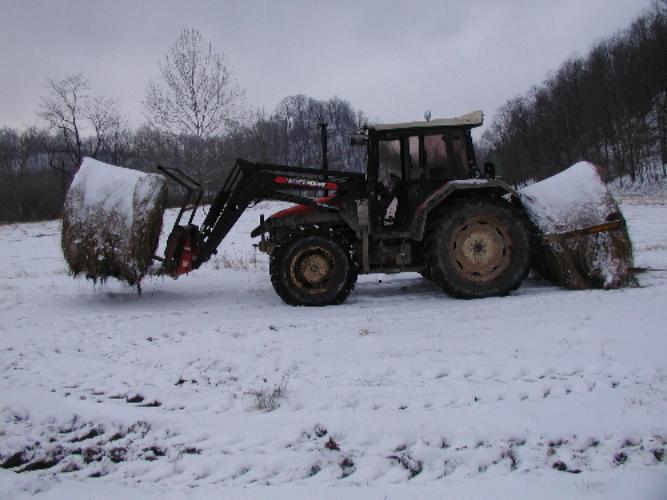
| Next Chapter | Previous Chapter | |
| Chapter 12: Mowing Grass | Contents | Chapter 10: Nostalgia: 1. Making Silage |
When I was a small kid the last of the horse equipment was discarded, and the first tractor equipment came into use. Horses were used on most farms to plow and disc, I saw lots of single plows pulled by two horses, operated by a man walking behind, and little disc harrows, which we called discs, used to work up the ground after the plow. These discs were like the ones we use now, except the operator sat on the disc harrow, and there were only about eight or ten discs on the axle.
On our farm horse drew a corn planter, a device that could plant one row at a time, and held about a gallon or two of corn, and perhaps 4 gallons of fertilizer. We used fertilizer in the East when they disdained it in the Midwest. They didn't really start using it in the Midwest until decades after we did. The horse also pulled the cultivator that weeded the corn and potatoes and garden, the shovel plow that dug rows for potatoes for home use, and on some farms the rarer double shovel plow. These all used one horse, which required considerable training. A man walked behind and drove the horse, and operated the tool with handles. This was much hard work. Considerably less time doing the work was involved than when hand tools only were used, however, as earlier generations had.
Horses drew the mowing machine to cut hay, the rake to rake it into windrows, drew the pole to move it to the stack, or the wagon to carry it to the barn, and to pull the rope to bring it up into the haymow. By the time I began to make observations in the late 1930s, horses were obsolete for road transportation. The main roads were paved, cars were used for travel, and trucks were used to haul cattle and materials used on the farm.
My father remembered moving to the Lost Creek farm from his father's place on Hackers Creek in Upshur County. He remembered when cattle were moved by herding along the public roads. He said there were herds driven by the house at Lost Creek that sometimes took all day to pass. They
(Illustration 11-1)

These are Grandfather Kennedy's work horses. Dad sold ours in 1941 when he bought the tractor. I was nearly eight but remember them well with no great fondness, although Dad and other older men loved the horses. Today there are almost no work (draft) horses, which have much heaver muscling than riding horses.
were western cattle that were brought in to North Central West Virginia to be fattened for market on our good bluegrass and white clover pastures. The Maxwells were great landowners in those days, and some of the cattle belonging to them were driven from the railroad at Lost Creek all the way to Doddridge County, then back when they were fat. Dozens of men and boys were employed in moving these herds. Dad said you were very, very careful about your fence along the road. If the cattle started in, everything would be ruined before they could be gotten out, between grazing and cattle feet, and human and horse feet trampling the crop.
Before the railroad came to Lost Creek in 1887, to get the best price cattle had to be driven on foot to Baltimore, and pigs and even turkeys, too, hard to believe as that is. They often went through areas that had no fences. The railroad was a great boon to cattle farming in the area, but it maintained a diversified farming industry for quite a while. Now it is almost entirely cow-calf farming, what is called ranching in the West.
Going back to horse transportation. There was only one horse and buggy on the road by the time I am able to remember. Uncle Gord (Gordon) Kennedy and Aunt Molly always drove a horse and buggy to church and the store as long as they lived. There was a pair of large trees in the fence line of the lot across the trolley line from the SDB church, about where the parsonage now stands. Uncle Gord's horse was usually tied there during any service. Gordon Kennedy was my Grandfather' s brother. He had been a teamster and loved horses.
The time of my father's reminisce about the herds of cattle going by the Lost Creek farm was around1912 and a few years after. Trucks had come in long before WWII, and there were local markets in Weston, Bridgeport, and Buckhannon within easy reach, and many slaughter animals were transported to Pittsburgh, and some to Baltimore, on trucks, because the price was usually better there.
Our first 8N tractor was purchased within a year of the outbreak of World War II, and served well through that period until about 1949 when a replacement 8N was purchased. There were two important changes in the new tractor: the rubber tires and a simple hydraulic lift to raise implements from the work position to the carry position. Grandfather Kennedy thought Dad should keep horses for the hillsides, but Dad realized the 8N had much better potential for working on hillsides than the old Fordson and said
(Illustration 11-2)

Moving round bales in winter with the Same Top 90 tractor
anything he couldn't get with the 8N he would let grow up. The horses had to go. Sure enough, there was never a better hillside tractor for at least 50 years. There wasn't much land abandoned on our farm.
A little on the knob, and that was all.
Aside My daughter Charlita has a sampler on the wall, made by her maternal grandmother, Mildred Hansen, that says, "A day in the country is worth a month in town." That about says it for all of us.
| Next Chapter | Previous Chapter | |
| Chapter 12: Mowing Grass | Contents | Chapter 10: Nostalgia: 1. Making Silage |
Copyright © 1998, 2006, 2008, 2011 S. Tom Bond (stombond at hughes.net)